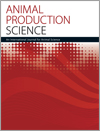Our study explored genetic factors influencing gestation length and traits indicative of productive, reproductive, and morphological performance in Angus cattle, showing potential challenges in calving due to selective breeding decisions. We recommend integrating calving-difficulty measures into selection indices, utilising first-gestation length as a practical alternative, and caution against culling decisions solely based on limited gestation records. This insight is crucial for improving selection criteria and ensuring the survival and growth rates in the studied herds.

Animal Production Science
Volume 64 Number 2 2024
Weaning decreased bodyweight, imbalanced T lymphocyte distribution, lowered concentration of sIgA and anti-inflammatory cytokines, and increased concentration of pro-inflammatory cytokines in piglets. The impairment of intestinal immune barrier function, which might be associated with the Notch2 signalling, was more severe 3 days post-weaning than at 7 days post-weaning.
Poor performance in broilers constitute challenges from different viewpoints including health, and welfare. Understanding the physiological differences between the high- and low-weight chicks may provide a useful insight into designing the best strategy to mitigate poor performance. This study reported that the low-weight chicks had low gizzard pH and high gizzard fibre content compared with the high-weight chicks. This requires further investigation to understand wheter this relates to feeding behaviour such as litter eating.
For better monitoring of the results in beef cattle based on native grassland pastoral systems, it is essential to know the quality of the diet ingested by the animals. The paper presents consistent results of the relationship between the composition of faeces and the diet consumed by cattle. The generated equations can serve as support for experiments in grazing and for nutritional assessment models of commercial herds.
The paper provides a clear overview of hemp’s description, historical production, chemical characterisation, potentials uses and their effects on the growth, reproduction and health of farm animals, and discusses the hemp’s potential applications in the medical and feed industries.
AN23268 Abstract | AN23268 Full Text | AN23268PDF (5.9 MB) Open Access Article
Commercial ducks can often experience high ambient temperatures in summer that adversely affect performance. Pekin ducks were fed grower diets (Days 22–41) with a low or high dietary electrolyte balance. Birds were exposed to a daily high temperature challenge for 9 h on Days 36–41 and provided with water supplemented with an electrolyte formulation at different concentrations with betaine or with betaine alone in the feed. The level of the electrolyte water supplement supporting higher liveweight gain depended on the dietary electrolyte balance.
AN23186 Abstract | AN23186 Full Text | AN23186PDF (499 KB) Open Access Article
Little is known about on-farm attitudes towards youngstock on Australian dairy farms, or their management, particularly in the period between replacement heifer weaning and first calving. This study describes some attitudes towards youngstock on Australian dairies, taken from a convenience sample of stockpeople involved in their management. Our results provide a foundation for future research describing calf-rearing practices, pathways to support best-practice management, and the attitudes and behaviours held by Australian dairy stockpeople towards youngstock under their care.
AN23249 Abstract | AN23249 Full Text | AN23249PDF (1.6 MB) | AN23249Supplementary Material (1.4 MB) Open Access Article
For Merino sheep industries, flystrike causes a loss of about A$320 million per year. Blow flies use their antennae to detect odours, so odour chemistry could help accelerate breeding for flystrike resistance. Blowfly olfaction is studied with electrophysiology, mass spectrometry and behaviour. We now know that octanal and nonanal attract blow flies and are affected by flystrike resistance.
AN23238 Abstract | AN23238 Full Text | AN23238PDF (2.1 MB) Open Access Article




